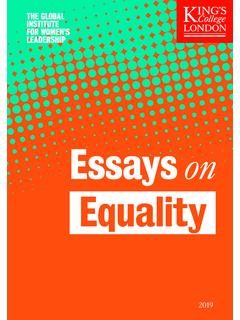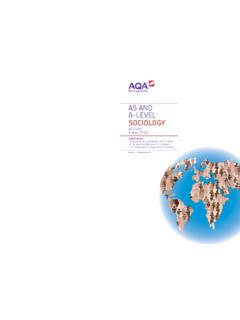Transcription of Economics briefs Six big ideas - The Economist - World ...
1 Economics briefsSix big ideas2 Economics BriefsThe EconomistIT IS easy enough to criticise economists : too superior, too blinkered, too often wrong. Paul Samuelson, one of the discipline s great figures, once lampooned stockmarkets for predicting nine out of the last five recessions. economists , in contrast, barely ever see downturns coming. They failed to predict the 2007-08 financial this is not the best test of success. Much as doctors understand diseases but cannot predict when you will fall ill, economists fundamental mission is not to forecast recessions but to explain how the World works. During the summer of 2016, The Economist ran a series of briefs on important economic theories that did just that from the Nash equilibrium, a cornerstone of game theory, to the Mundell-Fleming trilemma, which lays bare the trade-offs countries face in their manage-ment of capital flows, exchange rates and monetary policy; from the financial-in-stability hypothesis of Hyman Minsky to the insights of Samuelson and Wolfgang Stolper on trade and wages; from John Maynard Keynes s thinking on the fiscal multiplier to George Akerlof s work on information asymmetry.
2 We have assem-bled these articles into this six breakthroughs are adverts not just for the value of Economics , but also for three other things: theory, maths and outsiders. More than ever, Economics to-day is an empirical discipline. But theory remains vital. Many policy failures might have been avoided if theoretical insights had been properly applied. The trilemma was outlined in the 1960s, and the fiscal multiplier dates back to the 1930s; both illuminate the current struggles of the euro zone and the sometimes self-defeating pursuit of austerity. Nor is the body of economic theory complete. From secular stagnation to climate change, the discipline needs big thinkers as well as big also needs mathematics.
3 economic papers are far too formulaic; models should be a means, not an end. But the symbols do matter. The job of economists is to impose mathematical rigour on intuitions about markets, economies and peo-ple. Maths was needed to formalise most of the ideas in our Economics , as in other fields, a fresh eye can also make a big difference. New ideas often meet resistance. Mr Akerlof s paper was rejected by several journals, one on the ground that if it was correct, Economics would be different . Recogni-tion came slowly for many of our theories: Minsky stayed in relative obscurity un-til his death, gaining superstar status only once the financial crisis hit.
4 economists still tend to look down on outsiders. Behavioural Economics has broken down one silo by incorporating insights from psychology. More need to disappear: like anthropologists, economists should think more about how individuals decision-making relates to social mores; like physicists, they should study instability instead of assuming that economies naturally big economic ideasA collection of briefs on the discipline s seminal papers1 Published since September 1843to take part in a severe contest between intelligence, which presses forward, and an unworthy, timid ignorance obstructing our progress.
5 Editorial office:25 St James s StreetLondon SW1 1 HGTel: +44 (0) 20 7830 7000 IllustrationRobert Samuel Hanson Information asymmetry 4 Secrets and agents George Akerlof s 1970 paper, The Market for Lemons , is a foundation stone of information Economics . The first in our series on seminal economic ideas Financial stability 6 Minsky s moment The second article in our series on seminal economic ideas looks at Hyman Minsky s hypothesis that booms sow the seeds of busts Tariffs and wages 8 An inconvenient iota of truth The third in our series looks at the Stolper-Samuelson theorem Fiscal multipliers 10 Where does the buck stop?
6 Fiscal stimulus, an idea championed by John Maynard Keynes, has gone in and out of fashion Game theory 12 Prison breakthrough The fifth of our series on seminal economic ideas looks at the Nash equilibrium The Mundell-Fleming trilemma 14 Two out of three ain t bad A fixed exchange rate, monetary autonomy and the free flow of capital are incompatible, according to the last in our series of big economic ideas2016 GRE prep on your terms Sign up for your free trial at classes, no schedules, no textbooks. Just interactive GRE prep that you can access anytime, 11/7/2016 4:44:53 PM4 BritainThe Economist April 25th 2012IN 2007 the state of Washington intro-duced a new rule aimed at making the labour market fairer: firms were banned from checking job applicants credit scores.
7 Campaigners celebrated the new law as a step towards equality an applicant with a low credit score is much more likely to be poor, black or young. Since then, ten other states have followed suit. But when Robert Clifford and Daniel Shoag, two economists , recently studied the bans, they found that the laws left blacks and the young with fewer jobs, not 1970, economists would not have found much in their discipline to help them mull this puzzle. Indeed, they did not think very hard about the role of information at all. In the labour market, for example, the textbooks mostly assumed that employers know the productivity of their workers or potential workers and, thanks to competition, pay them for exact-ly the value of what they might think that research upend-ing that conclusion would immediately be celebrated as an important breakthrough.
8 Yet when, in the late 1960s, George Akerlof wrote The Market for Lemons , which did just that, and later won its author a Nobel prize, the paper was rejected by three lead-ing journals. At the time, Mr Akerlof was an assistant professor at the University of California, Berkeley; he had only com-pleted his PhD, at MIT, in 1966. Perhaps as a result, the American economic Review thought his paper s insights trivial. The Re-view of economic Studies agreed. TheJour-nal of Political Economy had almost the opposite concern: it could not stomach the paper s implications. Mr Akerlof, now an emeritus professor at Berkeley and married to Janet Yellen, the chairman of the Federal Reserve, recalls the editor s complaint: If this is correct, Economics would be differ-ent.
9 In a way, the editors were all right. Mr Akerlof s idea, eventually published in the Quarterly Journal of Economics in 1970, was at once simple and revolutionary. Sup-pose buyers in the used-car market value good cars peaches at $1,000, and sell-ers at slightly less. A malfunctioning used car a lemon is worth only $500 to buy-ers (and, again, slightly less to sellers). If buyers can tell lemons and peaches apart, trade in both will flourish. In reality, buy-Information asymmetry Secrets and agentsGeorge Akerlof s 1970 paper, The Market for Lemons , is a foundation stone of information Economics .
10 The first in our series on seminal economic ideas1 Economics BriefsThe Economist1ers might struggle to tell the difference: scratches can be touched up, engine prob-lems left undisclosed, even odometers tampered account for the risk that a car is a lemon, buyers cut their offers. They might be willing to pay, say, $750 for a car they perceive as having an even chance of be-ing a lemon or a peach. But dealers who know for sure they have a peach will re-ject such an offer. As a result, the buyers face adverse selection : the only sellers who will be prepared to accept $750 will be those who know they are offloading a buyers can foresee this prob-lem.
















